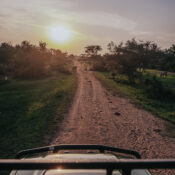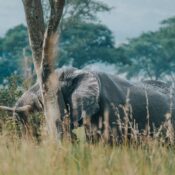The Uganda Museum facts
The Uganda Museum facts

The Uganda Museum is the biggest and the oldest Museum in Uganda which started in 1908 at Lugard’s fort on old Kampala Hill in Kampala city. It later moved to Makerere University at the school of industrial and fine arts and lastly to Kitante Hill where it stands today. the Museum has different sections including
Traditional music section with the traditional musical instruments and a live performance is available for the visitors Archaeology section with the parts of Stone Age and Iron Age where you will be able to see the stone tools which were used 1,000,000 years ago Independence pavilion of science and industry having transport (7th car in Uganda), communication (model of the 1st telephone in East Africa)
Ethnology history with the things of recent history like the first printing press in Uganda Ethnography providing the visitors with the touch of cultures and peoples’ way of life Palaeontology with the fossils aged about 20,000,000 years ago.
The ethnography section holds more than 100,000 object of historical and cultural value. A traditional reed door leads to exhibits on health, knowledge systems, objects of warfare, traditional dressing and other various ceremonial practices in Uganda
History
Fossil hominidae age between 19–20 million years ago from Napak-Uganda
The Uganda Museum carries out research across the country, with intensive research in the Karamoja region (Napak, Moroto and Kadam), Eastern Uganda at the foothills of Mount Elgon (Bukwo) and the whole of the western rift to Dellu, near Uganda’s border with Sudan. The Paleontological Research Unit has yielded fossils that relate to human evolution. For instance, Uganda Pithecus (fossil skull of a remote cousin of Hominidae) is fossil ape, aged between 19 and 20 million years, that was discovered in Napak. Paleoenvironmental research around heritage sites has also taken place in eastern and western Uganda.
Collections
A wide range of collections exist from the 1960s to the present. Specimens are displayed in the Natural History/Palaeontology Gallery which is open to the public. Collections in storage are available to researchers and students on request.
Publications]Publications of findings can be found in various journals including the Geo-Pal, an online Uganda Scientific Journal.
Education service
Apart from the permanent exhibits in the galleries, the Uganda Museum offers educational service in form of demonstration lessons, outreach programs, workshops and complimentary services. Using the available specimens, the museum arranges a variety of topical lessons related to the school curriculum. Student tours are conducted around the museum, as well as giving introductory lectures with slides, films, and other aids.
The museum staff from the education section go into the more remote areas of the country to teach in villages whose schools are not able to visit the museums. Some objects are loaned out to schools to be used as visual aids. The museum hosts lectures, public talks and workshops on relevant topics to the public in the auditorium. The museum is well equipped with facilities, such as canteen and internet cafe, which offer a variety of traditional foods of Uganda, and gift shops that showcase Uganda’s crafts.[5]
Cultural village
The Cultural Village at the Uganda Museum depicting the different architectural and traditional lifestyles in Uganda
At the back of the Uganda Museum building is the cultural village with huts depicting traditional lifestyles of people in Uganda. For visitors who want to experience the indigenous ways of the Ugandan people, an array of cultural material, such as milk pots made from wood (ebyanzi), gourd vessels, basketry, bead work, horn work, ceramics, cutlery, leather works, armoury, and musical instruments, are displayed. These houses include Bamba
House, Batooro House, Bunyoro House, Hima House, Ankole House and Kigezi House, all representing the western region. Some of the more interesting items in the Tooro House, are the bedding, especially the makeshift wooden bed, the backcloth blanket, and the royal drums.
In the Ankole House that belongs to Banyankole, there are cooking utensils like pots, bowls made of clay and a mingling stone showing how the Banyankole used to prepare millet bread (Kalo) before the invention of milling machines. In the Hima House that belongs to the Bahima, there are milk gourds used for keeping milk and long horns representing the type of cattle that used to dominate the Hima kraals. There is also a lotion made from milk that was used to smear a would-be bride.
From eastern Uganda there is Busoga House, Jopadhola House, Bugisu House, Teso House and Karamojong House. The Bugisu House is dotted with circumcision tools, including knives and headgear, among other regalia. In the Teso House there are several calabashes used for brewing and drinking Malwa, a popular local brew in eastern Uganda. There are also mingling stones and pots for preparing kalo, which is one of their main foods. Other houses include Acholi House, Lango House, Alur House and Madi House all from northern Uganda.
Some of these houses contain arrows and bows which were mainly used for protection tools and for hunting. The Baganda House represents people from the central region. Inside the house there is backcloth, drums, baskets for Luwombo, hunting nets, wooden sandals (emikalabanda), and the Omweso game popular among the Baganda.
- Bamba House
- Lango House
- Acholi House
- Acholi Old man House
- Bunyoro House
- Madi House
- Ankole House
- Hima House
- Alur House Granary
- Teso House
- Tooro House
- Kigezi House
- Alur house
- Busoga house
- Karamoja house
- Japadhola house
Architecture
The museum building is a historical landmark designed by German architect Ernst May. The building was designed with ample natural lighting and air to ensure proper preservation of objects.
Threats to the museum
During 2011, the Uganda Museum complex (that includes the headquarters of Uganda Wildlife Authority) was under threat of demolition. The Uganda Government was planning to build an “East African Trade Center” (sometimes referred to as the Kampala Tower) on the site. In 2011, four civil society organisations, the Historic Resources Conservation Initiatives (HRCI), Cross Cultural Foundation of Uganda (CCFU), Historical Buildings Conservation Trust (HBCT) and Jenga Afrika, took the Government of the Republic of Uganda to court to halt the government’s plans.

for more details visit:
All Categories
Recent Posts
Kidepo Valley National Park
The Kabaka’s lake
What is the African elephant?
Tags
Quick booking process
+256 393254072


